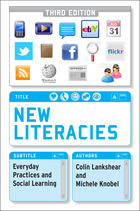Thursday, August 29, 2013
Our new book: "A New Literacies Reader"
Colin and I have a new book out, as well. It's compilation of research cases from across our "New Literacies and Digital Epistemologies" series with Peter Lang. The collection is titled, "A New Literacies Reader: Educational Perspectives".
From the back cover:
A New Literacies Reader is an introduction to social and cultural studies of new literacies from the perspectives of educators, education researchers and learners. It focuses on how participating in social practices of new literacies can be seen and understood in terms of people becoming insiders to ways of «doing» and «being» that are today considered desirable or worthwhile, and how this can usefully inform how we think about formal schooling and learning. The book’s 18 chapters cover a variety of topics, including:
The diverse topics addressed range from multimodal pedagogies, remix, performance poetry, and digital storytelling to issues associated with wireless environments, assessment, identity, and teachers’ ways of taking up new technologies. Chapters explore how young people participate and collaborate within the spaces of popular cultural interests and the various approaches to researching gaming. The book speaks to teachers and teacher educators, education administrators, curriculum developers, education policy makers, professional development specialists, postgraduate research students, and other literacy and new media researchers. A New Literacies Reader is an essential volume for undergraduates, grad students, and faculty interested in refining their knowledge of the vast new horizons created by the world of new literacies.
New book in our series: "Children's Virtual Play Worlds"
Loads of congratulations to Anne Burke and Jackie Marsh on the publication of their new edited collection, Children's Virtual Play Worlds: Culture, Learning and Participation!
From the back cover:
As children’s digital lives become more relevant to schools and educators, the question of play and learning is being revisited in new and interesting ways. Children’s Virtual Play Worlds: Culture, Learning, and Participation provides a more reasoned account of children’s play engagements in virtual worlds through a number of scholarly perspectives, exploring key concerns and issues which have come to the forefront. The global nature of the research in this edited volume embraces many different areas of study from school based research, sociology, cultural studies, psychology, to contract law showing how children’s play and learning in virtual spaces has great potential and possibilities.
Contents include:
Chapter 1: Anne Burke and Jackie Marsh: Introduction: The changing landscapes of children’s play worlds
Chapter 2: Susan Edwards: Post-industrial play: Understanding the relationship between traditional and converged forms of play in the early years
Chapter 3: Kaveri Subrahmanyam: Developmental implications for children’s virtual worlds
Chapter 4: Anne Burke: Stardolls and the virtual playground: How identity construction works in the new digital frontier
Chapter 5: Jackie Marsh: Breaking the ice: Play, friendships and online identities in young children’s use of virtual worlds
Chapter 6:Karen E. Wohlwend and Tolga Kargin: «Cause I know how to get friends - plus they like my dancing»: (L)earning the Nexus of Practice in Club Penguin
Chapter 7: Jan Connelly: Virtual clay or virtual play: Identity shaping, consumer building and corporate affiliation versus literacies affordance inside barbiegirls.com
Chapter 8: Isabel Pederson and Jennifer Rowsell: May the force be with you: Harnessing the power of brain-computer games
Chapter 9: Stephanie M. Reich, Ksenia A. Korobkova, Rebecca W. Black and Mariya Sumaroka: «Hey! Can you show me how to do this?» Digital games as a mediator of family time
Chapter 10: Sara M. Grimes: Digital play structures: Examining the terms of use (and play) found in children’s commercial virtual worlds
Chapter 12: Eric Meyers and Robert Bittner: Green pixels to green behaviours: Sustainability literacy in virtual worlds for children
Chapter 13: Victoria Carrington: An argument for assemblage theory: Integrated spaces, mobility, and polycentricity.
Afterword: Jackie Marsh and Anne Burke
New book in our series: "Arts, Media and Justice"
Lalitha has just let me know that all author-related proceeds from the book go to support creative work going on at a local alternative to detention program (ATD) in NYC. So buy a copy early early and often! :D
From the back cover:
In Arts, Media, and Justice, the aesthetic contours of literacies and communication are explored through a collection of chapters authored by educators, emerging and established researchers, youth researchers, and teaching artists whose lives intersect with those of young people inside and outside of formal institutional settings. At the heart of the varied research and curricular projects ranging from writing workshops and photography walks to a theater elective at an alternative to incarceration program—represented in this volume is the pursuit of play, imagination, multimodal expression. The authors share their experiences working with court-involved youth to explore issues related to justice, community, identity, and representation through engagement with multiple media and modes—including photography, theater, writing, painting, and video.
Contents include:
Foreword: Glynda Hull
Wednesday, August 28, 2013
New book in our series
Congratulations go out to Mira-Lisa Katz on her edited collection, Moving Ideas: Multimodality and Embodied Learning in Communities and Schools.
From the back cover:
What does it look and feel like to communicate, create, compose, comprehend, teach, and learn with our bodies? Reaching beyond existing scholarship on multimodality and literacies, Moving Ideas expands our capacity to understand the embodied dimensions of learning and stretches our repertoires for more artfully describing them. Wresting language away from its historically privileged place at the center of social science research and practice, this collection examines the strategic layering across semiotic modes, challenging educators and researchers to revisit many of our most elemental assumptions about communication, learning, and development. The corporeal pedagogies these authors describe illuminate a powerful kind of learning that we know far too little about; in this age of accountability and high-stakes testing, failing to pay adequate attention to the promise of multimodality means forfeiting significant resources that could be used to innovatively engage people of all ages in education broadly conceived.
Contents include:
Tuesday, August 27, 2013
Chromecasting
We were appropriately stunned when we read about the availability of the Google Chromecast dongle and pre-ordered on Amazon as soon as we had heard about it. It eventually shipped, and must have arrived here a few weeks back.
After driving the 2000 kilometres and sleeping through the overnight ferry trip to get us back to New Jersey from Newfoundland, we still had the will and energy to throw the Chomecaster into the TV and set it up on the computer inside the Chrome browser. Not much energy was needed, because only a couple of clicks were involved, and in no time at all we had whatever we wanted to run on the browser casting through the TV, for the ridiculously low price of $35 -- the price tag on the Chromecast dongle.
The quality is great, and with Netflix running at $7.99 a month it is tempting to simply drop the cable 'service' and merely retain the internet service.
The Chromecast device has the intuitive simplicity, elegance, and efficiency one normally associates with Apple products. It is simply fantastic. Of course, there are things you can't do with it that you can do with a full blown device like a Roku or an Apple TV or similar. On the other hand, these don't come at $35.
'Piracy' becomes a non issue under sensible conditions like Chromecasting Netflix.
And working becomes an endangered activity, one suspects .....












